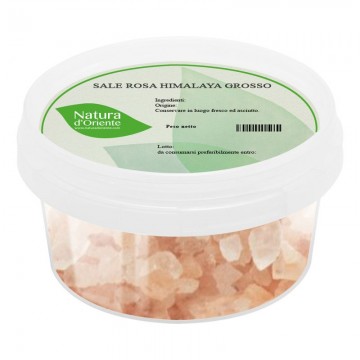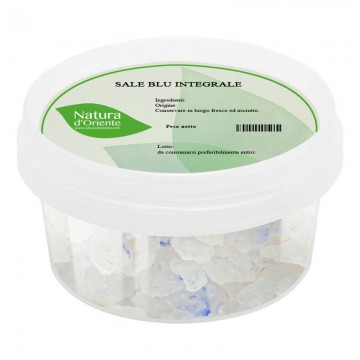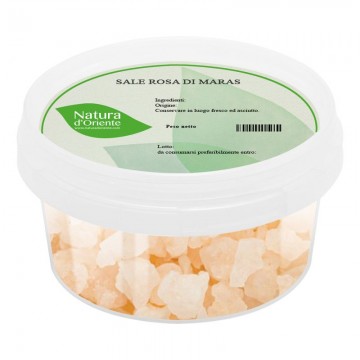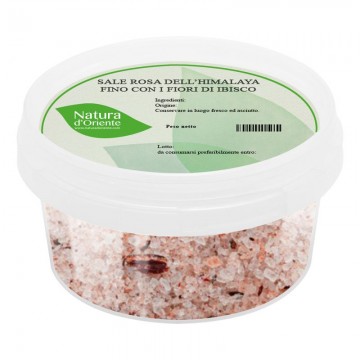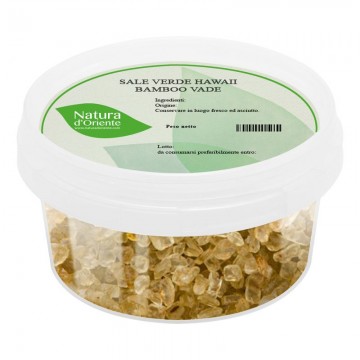It is believed that this rock salt is the purest salt, preserved in the depths of the pristine Himalayan mountains. It is harvested by hand from the stones found inside the mines of Kewra, Pakistan. Even this version reduced to fine pink salt, the crystals retain their properties.
Pink fine Himalayan salt: characteristics and benefits
Himalayan salt crystals can vary their color range from white to pink to dark red. This depends on the point of extraction, and on the minerals contained: the high content of iron oxide gives this salt the beautiful shades of pink and peach color, which make it famous. In any case, Himalayan salt has a total of 84 elements including trace minerals, minerals and metals. Of these many ingredients, several play an important role in our biological processes. Contains macro-minerals such as calcium and chloride and trace minerals such as iron and zinc. This pink salt makes elements already present in our body available, strengthening them. It is therefore known as an essential salt for the proper functioning of the organs of our body. Daily use of this salt can contribute to the correct intake of all nutrients. There is a lot of talk about its useful properties for the well-being of the skin, and for this reason the Himalayan pink salt is often used in spas or in the wellness sector for care and relaxation. Among its food properties, it stimulates circulation, helps regulate blood pressure and remove toxins, such as heavy metals. Other benefits of Himalayan pink salt include its low sodium content and high potassium intake - a useful combination for balancing the sodium-potassium ratio, and promoting cardiovascular and muscle well-being. It has a beneficial effect on the pH of the body by regulating acidity. In addition, its content of magnesium and selenium are useful for the proper functioning of the body. This version of Himalayan fine salt is more suitable in the kitchen as a condiment, but can also be used in concentrated hydrosaline solution - pink salt mixed in a glass of water. A hydrating and energetic drink. It is a salt that contains little iodine, since it is a rock salt that comes from land mines and is not a sea salt. An important factor for those who must avoid iodine in their diet.
Origins and History of the extraction
The pink Himalayan salt comes from the Himalayan salt mines located in Khewra, in the Punjab region, Pakistan. They are considered among the largest salt mines in the world, dating back to the secondary era, and are found at the foot of the Himalayan mountain ranges. These are rocks that probably derive from the evaporation of a huge sea, dating back to the Precambrian era. Due to the alterations and movements of the tectonic plates, many geographical changes occurred in this area, which led to volcanic eruptions and the great evaporation of the sea. If the water disappeared, and with it the marine animals, huge deposits of salt remained in the ground, well protected by the blanket of volcanic lava. For this reason, the Himalayan pink salt is considered a fossil salt, with about 250 million years (dating back to the Jurassic era). In recent times, the Khewra mine was discovered in the 4th century BC. by Alexander the Great, and then the work of salt extraction was intensified in the Middle Ages, until today a nineteen-story mining system is reached. The color of the salt varies according to the levels at which it is extracted, from pale pink to bright red. Recently, the Himalayan pink salt was launched on the western market in the nineties, after the promotion of Peter Ferreira, a biophysicist who pointed out its benefits and properties.
Nutritional values of pink Himalayan salt
This salt contains mostly sodium chloride, as well as traces of trace elements, metals and minerals such as calcium, magnesium, phosphorus, potassium, zinc, copper, manganese, silicon, sulfur and iron. In addition to macro-minerals, it contains hydrogen and oxygen, trapped in the rocks.
How to use pink Himalayan salt in the kitchen
It is a delicate salt, less savory than common salt, and is excellent for enhancing the flavor of meat and fish with its mineral notes - both roasted and grilled, which cone other types of cooking. Its delicate flavor and fragrance can enhance freshwater fish and not too tasty white meats. On second courses of any kind, this salt does not cover the taste of the meat, giving it a soft flavorand salty, less metallic than some types of common salt and iodized. It can provide some sulphurous notes, excellent on hard-boiled eggs, and is also successfully used for soups and vegetables. The version of this fine pink salt is excellent for salads and for marinating. The pink Himalayan salt has a round taste and a soft sapidity, which also make it perfect as a condiment on every recipe, for first courses, side dishes and up to dessert. Some pastry chefs also pair it with creams, chocolate, ice cream and caramel. Several chefs use pink salt for its beauty, as a garnish: perfect for presenting dishes in an original way. In this finely ground version, it is a splendid salt to decorate the rim of cocktail glasses, perfect in rimmer.
Pink Himalayan salt: side effects and contraindications
As with any other type of salt, you must not exceed the consumption of this rock salt at the table. Caution is advised in taking salt in case of hypertension, cardiovascular disorders and diseases related to blood vessels. It could cause water retention, which is harmful for those suffering from liver cirrhosis and kidney diseases. Furthermore, it is good to moderate the quantities during pregnancy and breastfeeding.


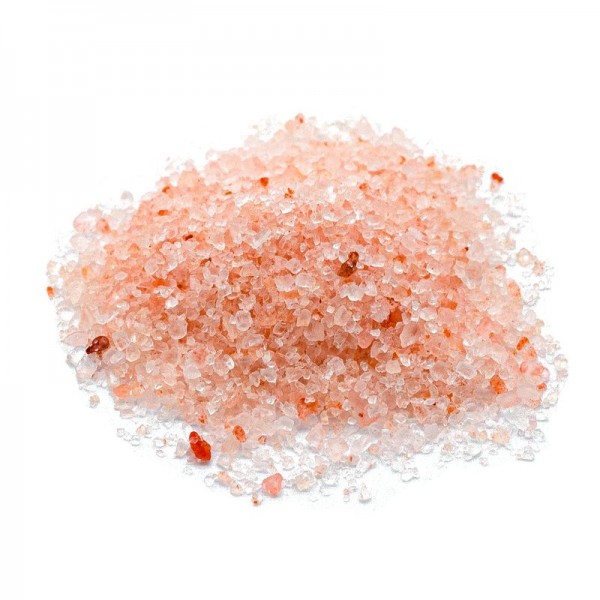






 No reward points for this product.
No reward points for this product.
